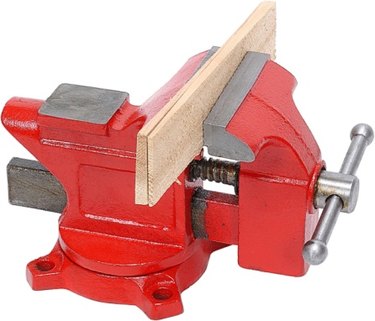
The beauty, strength and versatility of wood make it a useful material for producing items, from small toothpicks to large log cabins. When working with wood, tools that hold pieces in place can serve a few purposes. This includes securely holding a wood piece to make it easier and safer to work on, as well as clamping pieces when gluing them together.
Bench Stop
Video of the Day
One of the simplest options for holding wood in place is a bench stop. This is a small wood or metal device secured on a workbench so that it projects above the top surface. A wood piece placed on the workbench and braced against the bench stop will be held in place during planing or sanding.
Video of the Day
Bench Vise
A bench vise also helps to hold a wood piece in place while working on it. A vise mounts securely onto a workbench, with the wood piece held between two parallel metal jaws. The jaws screw open and closed to suit different thicknesses of wood, and when screwed together, they apply pressure to clamp the wood securely in place. The jaws can have a smooth face to limit damage to the wood, although in some cases can have a serrated edge which digs into the wood to more securely hold it.
Bar Clamp
Woodworking clamps have a use in holding pieces as they are glued together. They come in a variety of shapes and sizes, with the bar clamp a common style. This has a length of pipe or metal bar, with a metal jaw fixed on one end, and an adjustable jaw that can slide along the bar. The adjustable jaw can be fixed securely in position to suit the size of wood, and a screw tightened to apply pressure to hold glued pieces tightly together.
C-Clamp
The C-clamp is another of the common clamp styles. This comprises a metal tool in the shape of the letter C, with a threaded screw sitting across the open section of the C. The screw can be loosened to open a gap into which wood pieces fit, and the screw then tightened to clamp these tightly together.
Quick-Release Clamps
Quick-release clamps typically have a similar style to bar clamps and are used for the same type of jobs. However, their design includes a quick-release mechanism. This enables faster removal, which can make them easier to use.
Specialty Clamps
Specialty clamps come in a variety of shapes and sizes, with examples of these including angle, edge, spring and strap clamps. These typically feature a design, which can help with more awkward clamping jobs.
Hand Screw
Hand screws typically feature two wooden jaws, held together by two metal screws or spindles. Turning both screws simultaneously opens and closes the jaws parallel to each other, enabling them to securely clamp wood pieces together. However, turning only one screw can slant the jaws slightly, and this can be useful for wood pieces that don't have parallel sides.